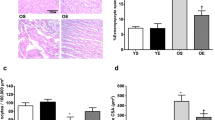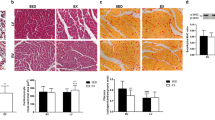Abstract
Even though exhaustive exercise-induced oxidative stress increases the risk of tissue damage, regular endurance training is widely assumed to improve cardiac function and protects against heart disease. We tested the hypothesis that an endurance training program prevents exhaustive exercise-induced increases in cardiac dysfunction and apoptosis in left ventricle (LV). Thirty-two male Sprague-Dawley rats were randomly divided into four groups: sedentary control (C), trained (T), exhaustively exercised (E), and trained plus exhaustively exercised (TE). Rats in T and TE groups ran on a motorized treadmill for 12 weeks. Rats in groups E and TE performed an exhaustive running test on a treadmill. The main effects of training were indicated by increased running time to exhaustion (80 ± 5 and 151 ± 13 min for groups E and TE, respectively, P = 0.0001), myocardial hypertrophy (0.38% and 0.47% for untrained and trained rats, respectively, P = 0.0002), decreased LV ejection fraction (88% and 71% for untrained and trained rats, respectively, P < 0.0001), accelerated mitochondrial DNA 4834-bp large deletion (mtDNA4834 deletion), and up-regulated protein levels of heat shock protein-70, cytochrome C, cleaved capsase-3, and cleaved PARP in LV following a bout of exhaustive exercise. Contrary to our hypothesis, these results suggest that endurance training induced significant impairment of regional systolic and diastolic LV myocardial function and ejection fraction in rats. Our findings show that endurance training accelerates exhaustive exercise-induced mtDNA4834 deletion and apoptosis in the LV.



Similar content being viewed by others
References
Antunes-Neto JM, Toyama MH, Carneiro EM, Boschero AC, Pereira-da-Silva L, Macedo DV (2006) Circulating leukocyte heat shock protein 70 (HSP70) and oxidative stress markers in rats after a bout of exhaustive exercise. Stress 9:107–115
Bedford TG, Tipton CM, Wilson NC, Oppliger RA, Gisolfi CV (1979) Maximum oxygen consumption of rats and its changes with various experimental procedures. J Appl Physiol 47:1278–1283
Beere HM, Wolf BB, Cain K, Mosser DD, Mahboubi A, Kuwana T, Tailor P, Morimoto RI, Cohen GM, Green DR (2000) Heat-shock protein 70 inhibits apoptosis by preventing recruitment of procaspase-9 to the Apaf-1 apoptosome. Nat Cell Biol 2:469–475
Branda RF, Brooks EM, Chen Z, Naud SJ, Nicklas JA (2002) Dietary modulation of mitochondrial DNA deletions and copy number after chemotherapy in rats. Mutat Res 501:29–36
Callejas NA, Casado M, Díaz-Guerra MJ, Boscá L, Martín-Sanz P (2001) Expression of cyclooxygenase-2 promotes the release of matrix metalloproteinase-2 and -9 in fetal rat hepatocytes. Hepatology 33:860–867
Chou YF, Yu CC, Huang RF (2007) Changes in mitochondrial DNA deletion, content, and biogenesis in folate-deficient tissues of young rats depend on mitochondrial folate and oxidative DNA injuries. J Nutr 137:2036–2042
Clarkson PM, Thompson HS (2000) Antioxidants: what role do they play in physical activity and health? Am J Clin Nutr 72:637S–646S
Cortopassi GA, Shibata D, Soong NW, Arnheim N (1992) A pattern of accumulation of a somatic deletion of mitochondrial DNA in aging human tissues. Proc Natl Acad Sci USA 89:7370–7374
Demirel HA, Hamilton KL, Shanely RA, Tümer N, Koroly MJ, Powers SK (2003) Age and attenuation of exercise-induced myocardial HSP72 accumulation. Am J Physiol Heart Circ Physiol 285:H1609–H1615
Frankiewicz-Jóźko A, Faff J, Sieradzan-Gabelska B (1996) Changes in concentrations of tissue free radical marker and serum creatine kinase during the post-exercise period in rats. Eur J Appl Physiol Occup Physiol 74:470–474
Gadaleta MN, Rainaldi G, Lezza AM, Milella F, Fracasso F, Cantatore P (1992) Mitochondrial DNA copy number and mitochondrial DNA deletion in adult and senescent rats. Mutat Res 275:181–193
Hamilton KL, Staib JL, Phillips T, Hess A, Lennon SL, Powers SK (2003) Exercise, antioxidants, and HSP72: protection against myocardial ischemia/reperfusion. Free Radic Biol Med 34:800–809
Huang CC, Tsai SC, Lin WT (2008) Potential ergogenic effects of l-arginine against oxidative and inflammatory stress induced by acute exercise in aging rats. Exp Gerontol 43:571–577
Ji LL (2008) Modulation of skeletal muscle antioxidant defense by exercise: role of redox signaling. Free Radic Biol Med 44:142–152
Kavazis AN, McClung JM, Hood DA, Powers SK (2008) Exercise induces a cardiac mitochondrial phenotype that resists apoptotic stimuli. Am J Physiol Heart Circ Physiol 294:H928–H935
Kim SH, Chi JG (1997) Characterization of a mitochondrial DNA deletion in patients with mitochondrial myopathy. Mol Cells 7:726–729
Le Page C, Noirez P, Courty J, Riou B, Swynghedauw B, Besse S (2009) Exercise training improves functional post-ischemic recovery in senescent heart. Exp Gerontol 44:177–182
Lee HC, Pang CY, Hsu HS, Wei YH (1994) Differential accumulations of 4,977 bp deletion in mitochondrial DNA of various tissues in human ageing. Biochim Biophys Acta 1226:37–43
Lee YI, Cho JY, Kim MH, Kim KB, Lee DJ, Lee KS (2006) Effects of exercise training on pathological cardiac hypertrophy related gene expression and apoptosis. Eur J Appl Physiol 97:216–224
Lee SD, Kuo WW, Bau DT, Ko FY, Wu FL, Kuo CH, Tsai FJ, Wang PS, Lu MC, Huang CY (2008) The coexistence of nocturnal sustained hypoxia and obesity additively increases cardiac apoptosis. J Appl Physiol 104:1144–1153
Lin WT, Yang SC, Tsai SC, Huang CC, Lee NY (2006) l-Arginine attenuates xanthine oxidase and myeloperoxidase activities in hearts of rats during exhaustive exercise. Br J Nutr 95:67–75
Linnane AW, Kovalenko S, Gingold EB (1998) The universality of bioenergetic disease. Age-associated cellular bioenergetic degradation and amelioration therapy. Ann N Y Acad Sci 854:202–213
Liu CC, Huang CC, Lin WT, Hsieh CC, Huang SY, Lin SJ, Yang SC (2005) Lycopene supplementation attenuated xanthine oxidase and myeloperoxidase activities in skeletal muscle tissues of rats after exhaustive exercise. Br J Nutr 94:595–601
Mansouri A, Gaou I, Fromenty B, Berson A, Lettéron P, Degott C, Erlinger S, Pessayre D (1997) Premature oxidative aging of hepatic mitochondrial DNA in Wilson’s disease. Gastroenterology 113:599–605
Marini M, Lapalombella R, Margonato V, Ronchi R, Samaja M, Scapin C, Gorza L, Maraldi T, Carinci P, Ventura C, Veicsteinas A (2007) Mild exercise training, cardioprotection and stress genes profile. Eur J Appl Physiol 99:503–510
Mikami T, Sumida S, Ishibashi Y, Ohta S (2004) Endurance exercise training inhibits activity of plasma GOT and liver caspase-3 of mice [correction of rats] exposed to stress by induction of heat shock protein 70. J Appl Physiol 96:1776–1781
Mooren FC, Blöming D, Lechtermann A, Lerch MM, Völker K (2002) Lymphocyte apoptosis after exhaustive and moderate exercise. J Appl Physiol 93:147–153
Pagenstecher A, Stalder AK, Kincaid CL, Volk B, Campbell IL (2000) Regulation of matrix metalloproteinases and their inhibitor genes in lipopolysaccharide-induced endotoxemia in mice. Am J Pathol 157:197–210
Powers SK, Locke AM, Demirel HA (2001) Exercise, heat shock proteins, and myocardial protection from I-R injury. Med Sci Sports Exerc 33:386–392
Powers SK, Quindry J, Hamilton K (2004) Aging, exercise, cardioprotection. Ann N Y Acad Sci 1019:462–470
Ravagnan L, Gurbuxani S, Susin SA, Maisse C, Daugas E, Zamzami N, Mak T, Jäättelä M, Penninger JM, Garrido C, Kroemer G (2001) Heat-shock protein 70 antagonizes apoptosis-inducing factor. Nat Cell Biol 3:839–843
Roldán V, Marín F, Gimeno JR, Ruiz-Espejo F, González J, Feliu E, García-Honrubia A, Saura D, de la Morena G, Valdés M, Vicente V (2008) Matrix metalloproteinases and tissue remodeling in hypertrophic cardiomyopathy. Am Heart J 156:85–91
Rullman E, Norrbom J, Strömberg A, Wågsäter D, Rundqvist H, Haas T, Gustafsson T (2009) Endurance exercise activates matrix metalloproteinases in human skeletal muscle. J Appl Physiol 106:804–812
Sakai Y, Iwamura Y, Hayashi J, Yamamoto N, Ohkoshi N, Nagata H (1999) Acute exercise causes mitochondrial DNA deletion in rat skeletal muscle. Muscle Nerve 22:258–261
Shyur LF, Huang CC, Lo CP, Chiu CY, Chen YP, Wang SY, Chang ST (2008) Hepatoprotective phytocompounds from Cryptomeria japonica are potent modulators of inflammatory mediators. Phytochemistry 69:1348–1358
Siu PM, Bryner RW, Martyn JK, Alway SE (2004) Apoptotic adaptations from exercise training in skeletal and cardiac muscles. FASEB J 18:1150–1152
Smolka MB, Zoppi CC, Alves AA, Silveira LR, Marangoni S, Pereira-Da-Silva L, Novello JC, Macedo DV (2000) HSP72 as a complementary protection against oxidative stress induced by exercise in the soleus muscle of rats. Am J Physiol Regul Integr Comp Physiol 279:R1539–R1545
Tanimura Y, Shimizu K, Tanabe K, Otsuki T, Yamauchi R, Matsubara Y, Iemitsu M, Maeda S, Ajisaka R (2008) Exercise-induced oxidative DNA damage and lymphocytopenia in sedentary young males. Med Sci Sports Exerc 40:1455–1462
Taylor RP, Harris MB, Starnes JW (1999) Acute exercise can improve cardioprotection without increasing heat shock protein content. Am J Physiol 276:H1098–H1102
Thorp DB, Haist JV, Leppard J, Milne KJ, Karmazyn M, Noble EG (2007) Exercise training improves myocardial tolerance to ischemia in male but not in female rats. Am J Physiol Regul Integr Comp Physiol 293:R363–R371
Tsai K, Hsu TG, Hsu KM, Cheng H, Liu TY, Hsu CF, Kong CW (2001) Oxidative DNA damage in human peripheral leukocytes induced by massive aerobic exercise. Free Radic Biol Med 31:1465–1472
Tupling AR, Bombardier E, Vigna C, Quadrilatero J, Fu M (2008) Interaction between Hsp70 and the SR Ca2+ pump: a potential mechanism for cytoprotection in heart and skeletal muscle. Appl Physiol Nutr Metab 33:1023–1032
Wang S, Ma JZ, Zhu SS, Xu DJ, Zou JG, Cao KJ (2008) Swimming training can affect intrinsic calcium current characteristics in rat myocardium. Eur J Appl Physiol 104:549–555
Watson PA, Reusch JE, McCune SA, Leinwand LA, Luckey SW, Konhilas JP, Brown DA, Chicco AJ, Sparagna GC, Long CS, Moore RL (2007) Restoration of CREB function is linked to completion and stabilization of adaptive cardiac hypertrophy in response to exercise. Am J Physiol Heart Circ Physiol 293:H246–H259
Wu HJ, Chen KT, Shee BW, Chang HC, Huang YJ, Yang RS (2004) Effects of 24 h ultra-marathon on biochemical and hematological parameters. World J Gastroenterol 10:2711–2714
Acknowledgments
This study was supported by the National Science Council of Taiwan (NSC-96-2413-H-029-003 and NSC-97-2410-H029-037-MY2). We thank Drs. Ming-Dar Tsa (Department of Neurological Surgery, Shin Kong Wu Ho-Su Memorial Hospital) and Shiow-Chwen Tsai (Taipei Physical Education College) for their technical support.
Author information
Authors and Affiliations
Corresponding author
Rights and permissions
About this article
Cite this article
Huang, CC., Lin, TJ., Chen, CC. et al. Endurance training accelerates exhaustive exercise-induced mitochondrial DNA deletion and apoptosis of left ventricle myocardium in rats. Eur J Appl Physiol 107, 697–706 (2009). https://doi.org/10.1007/s00421-009-1177-4
Accepted:
Published:
Issue Date:
DOI: https://doi.org/10.1007/s00421-009-1177-4




